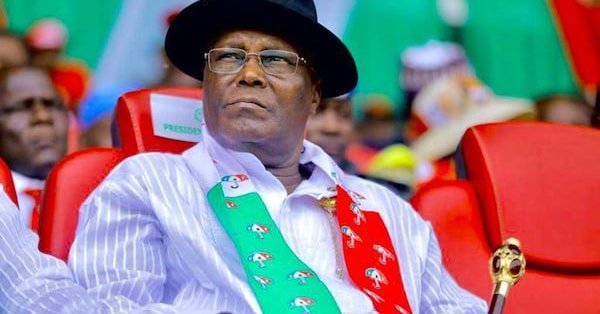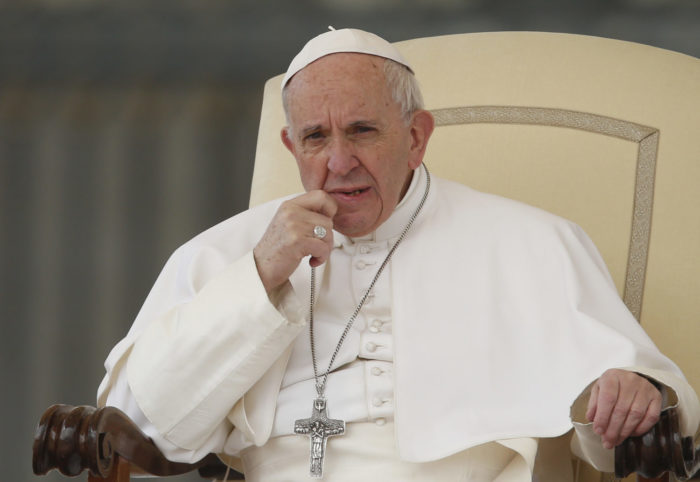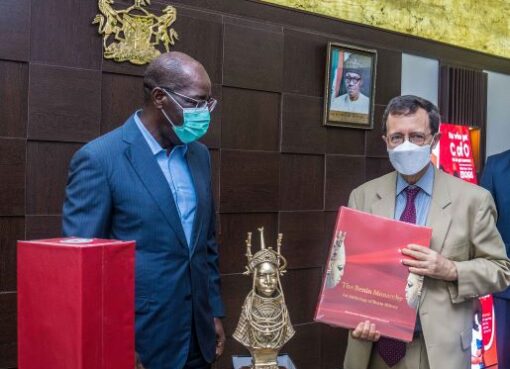Insist tribunal’s judgement was perverse, occasioned miscarriage of justice
Allege Buhari gave false information of fundamental nature
The Peoples Democratic Party, PDP, and its Presidential candidate in the last general election, Atiku Abubakar, on Tuesday, approached the Supreme Court, adducing reasons why President Muhammadu Buhari’s re-election should be nullified.
In a 66-ground of appeal they filed through a consortium of lawyers led by Dr. Livy Uzoukwu, SAN, the petitioners, insisted that the September 11 judgement of the Justice Mohammed Garba-led five-man panel Presidential Election Petition Tribunal that affirmed Buhari as valid winner of the presidential contest that held on February 11, was not only perverse but occasioned grave miscarriage of justice against them.
The appellants told the apex court that the tribunal wrongly evaluated gamut of evidence they produced to prove that Buhari lost the presidential election with over 1.6million votes, as well as the allegation that he was bereft of the requisite educational qualifications to vie for the presidency.
Insisting that President Buhari lied in the Form CF001 he submitted to the Independent National Electoral Commission, INEC, for the purpose of the election, the appellants, argued that the false information the 2nd Respondent gave to the electoral body was of a fundamental nature to warrant his removal from office.
They argued that the tribunal, “relied on assumptions and presumptions that the 2nd Respondent submitted his Certificates to the Military authorities”, to arrive at “gratuitous and unsolicited” conclusion that he was “eminently qualified to contest” the Presidential election.
More so, Atiku and his party contended that Justices of the Court of Appeal erred in law when they relied on “overall interest of justice” to hold that some documents Buhari produced to defend the petition against him, including his purported WAEC statement of result, were properly admitted in evidence, even when leave of the tribunal was not firstly sought or secured.
They argued that the tribunal gave restrictive interpretation to Section 76 of the Electoral Act 2010 (as amended) in order to exclude Form CF001 from its provisions, insisting that in the Form CF001 that was filled and submitted by all the candidates, “under the column for ‘Schools Attended/Educational Qualification with dates’, there is the clear provision: ‘Attach Evidence Of All Educational Qualification’. Certificates are evidence of educational qualifications.
“Form CF001 is designed to take care of the provision in section 31(2) of the Electoral Act (as amended) regarding the “list or information” a candidate is expected to submit and verify by an Affidavit.
“The prescription in Form CF001 for a candidate to attach evidence of all educational qualifications is part of statutory requirements. Form CF001 is made pursuant to statutory provisions.
“Clearly, the Appellants pleaded and proved the allegation that the 2nd Respondent gave false information of a fundamental nature to the 1st Respondent in aid of his qualification”, the appellants argued.
Besides, they contended that Buhari’s failure to produce his Certificates or attach same to the Form CF001 in the face of unequivocal denial by the Army that his Certificates were not with them, went to the root of the allegation that he gave false information of a fundamental nature to INEC regarding his qualification.
“The Appellants pleaded and proved the allegation that the 2nd Respondent gave false information of a fundamental nature to the 1st Respondent in aid of his qualification.
According to the appellants, the tribunal erred in law when it held that there was no evidence to disclaim or prove that Buhari lied that he went to Primary School, Secondary School in Katsina 1956 and 1961 and went to Nigerian Military Training from 1961 – 1963.
Listing particulars of error by the tribunal, the appellants argued that educational qualifications Buhari claimed were “Primary School Certificate”, “WASC” and “Officer Cadet”, noting however that “the 2nd Respondent did not attach any of them and claimed that they “are currently” with the Secretary to the Military Board in an affidavit he deposed to on November 24, 2014.
They argued that none of the witnesses established “in any manner whatsoever that the 2nd Respondent had the educational qualifications he claimed in Form CF001”.
Atiku and PDP told the apex court that the tribunal imposed a much higher burden of proof on them than what the law required.
“The Learned Justices of the Court of Appeal erred in law when, after relying on the provisions of sections 31(2), 31(4) and 76 of the Electoral Act, 2010 (as amended), held that it was not mandatory for the 2nd Respondent to have attached his academic qualifications to Form CF001.
“Having filled and submitted Form CF001 (Exhibit P1), the 2nd Respondent was bound to comply with all its requirements and as such estopped from contending the contrary. Form CF001 (Exhibit P1) ought to be considered and read holistically.The contents of Exhibit P1 requires mandatory compliance
“By Section 138(1) (e) of the Electoral Act, 2010 (as amended) the giving of false information of a fundamental nature in aid of a person’s qualification is now a statutory ground for maintaining Election Petition.
“The crucial issue in the Appellants’ case is that the purported claim of the 2nd Respondent that his “Primary School Leaving Certificate, WASC and Officer Cadet” is with the Secretary of the Military Board is false.
“As far back as 2014, the Nigerian Army came out to unequivocally deny that the Certificates of the 2nd Respondent are with them.
“Four years after the denial by the Army that the Certificates of the 2nd Respondent were with them, the 2nd Respondent who filled Form CF001 in October 2018 had a duty to attach his Certificates to the Form.
“The 2nd Respondent did not attach any evidence showing that “officer cadet” is a qualification or certificate. The 2nd Respondent’s witnesses led conflicting evidence on when the 2nd Respondent entered the Military School and the Court opted to rely on the date of 1962 without any explanation or the conflict being resolved.
“The lower court did not rely on evidence-led but relied on assumptions and presumptions that the 2nd Respondent submitted his Certificates to the Military authorities, despite the clear, unambiguous and direct evidence of RW1 to the contrary.
“The Learned Justices of the Court of Appeal treated the issue of educational qualification as if that was the sole ground of the Petition on disqualification of the 2nd Respondent without adverting to the ground that the 2nd Respondent gave false information of a fundamental nature to the 1st Respondent in aid of his qualification.
“The 2nd Respondent failed to produce a single Certificate in support of his claim, in Form CF001, notwithstanding the unequivocal denial by the Nigerian Army that his certificates were not with them. The conclusion of the lower Court was speculative and not based on any proven facts or evidence”.
They argued that the tribunal gave undue weight to President Buhari’s CV that was attached to the Form CF001, which it said was mere evidence of his working experience and not Certificate or qualification.
“The qualification of a candidate to contest for the office of the President of the Federal Republic of Nigeria under extant Laws is not such that can be established in a mere C.V (Curriculum Vitae)”.
On discrepancy in the name on the certificate that was produced as Buhari’s own, the appellants, stated: “The 2nd Respondent neither claimed in his pleadings nor evidence that at any time he was known as “Mohamed Buhari”.
“There is no evidence on record that the name “Buhari” refers and belongs to the 2nd Respondent exclusively. Neither the 2nd Respondent nor any witness called by him testified that he was at any time known as “Mohamed Buhari”.
“In a friendly cross-examination on behalf of the 3rd Respondent, RW5 merely answered that there is no difference between Mohammad, Mohammed, as it depends on the person pronouncing it. RW5 did not say there is no difference between “Mohamed” and “Muhammadu”.
“On the crucial issue of conflict between the names in Exhibits R19, R21 and P1 the court below called it “variation in the name of the 2nd Respondent”. The 2nd Respondent in his final Address called it “inconsequential discrepancies”.
“The 2nd Respondent did not plead that he had other names such as “Mohamed” “Mohammed” or “Muhammed” or that he is the only “Buhari” in the whole world. The 2nd Respondent did not plead that he is also known as “Mohammed Buhari” or Muhammed Buhari” or that “Muhammadu” and “Mohammed” or “Muhammed” or “Mohamed” are the same and refer to the 2nd Respondent.
“The 2nd Respondent’s name is clearly shown in Exhibit P1 (which was made by the 2nd Respondent under oath) as Muhammadu Buhari. The alleged report of the Principal of Provincial Secondary School Katsina made in 1961 and the records of the Military (Exhibit P24) relied on by the Lower Court referred and identified the 2nd Respondent as “Muhammadu Buhari” and no other name”.
The prohibition on the use of electronic voting contained in section 52(1) (b) of the Electoral Act, 2010 was amended and deleted therefrom by the Electoral (Amendment) Act, 2015 Government Notice No. 26 of 31 March 2015, Federal Republic of Nigeria Official Gazette.
On the disputed issue of electronic transmission of results, the appellants argued that INEC has powers under Section 153 of the Electoral Act, 2010 (as amended) to issue Regulations, Guidelines or Manuals for elections.
“Section 160(1) of the Constitution of the Federal Republic of Nigeria 1999 (as amended) confers powers on the 1st Respondents “to make its rules or otherwise regulate its own procedure.”
“Exhibits P27, P28 and P33 were the products of the exercise of statutory powers conferred on the 1st Respondent by the Constitution. Exhibit P33 contains provisions on the use of Smart Card Readers for electronic collation and electronic transmission of results.
“Neither the Supreme Court nor the Court of Appeal has interpreted the extant provisions of Section 52(2) of the Electoral Act (as amended) in relation to the electronic collation and transmission of results.
“The Learned Justices of the Court of Appeal erred in law when they relied on the cases of WIKE EZENWO NYESOM –VS- HON DR. DAKUKU ADOL PETERSIDE & ORS (2016) 7 NWLR (PT. 1512) 452 @ 522 and PDP –VS- ALEX OTTI & ORS (2016) 8 NWLR (PT. 1513) 111 @ 122 to hold that Smart Card Reader Machine cannot be used at elections”.
According to the appellants, “At the time of the decisions in the two cases supra, the extant Section 52 (2) had not been inserted into the Electoral Act to give the 1st Respondent the discretion to determine the procedure to be followed in an election.
“The issue of Smart Card Readers Machines, which is before the Justices of the court below is not the same as electronic voting. The issue of electronic transmission of result which was before the lower court is not the same as electronic voting.
“The Appellants pleaded that the 1st Respondent adopted electronic transmission of results in the conduct of the election and led evidence in line with their pleadings.
By virtue of the provisions of Sections 52(2) and 153 of the Electoral Act, 2010 (as amended) and Section 160 of the Constitution of the Federal Republic of Nigeria 1999 (as amended), the 1st Respondent made Exhibits P27, P28 and P33.
“Exhibits P27, P28 and P33 made provisions for electronic collation and transmission of results. Exhibits P27, P28 and P33 are subsidiary legislations which have the force of law and these Guidelines/Manuals expressly state that Card Readers are not just for authentication and accreditation but also for e-collation and e-transmission of results.
“The Appellants led evidence through PW2, PW4, PW16, PW17 and PW36 to establish the fact that there were electronic collation and transmission of results vide Smart Card Reader to a Central Server.
“The said PW2, PW4, PW16, PW17 and PW36 were INEC ad-hoc staff recruited and trained on how to conduct the Presidential Election and transmit the results electronically to a Server vide Smart Card Reader with the aid of classified code number.
“The evidence led by PW2, PW4, PW16, PW17 and PW36 was not controverted by any of the Respondents particularly the 1st Respondent, who did not even bother to produce or lead evidence to deny or disown the fact that those witnesses were its ad-hoc staff.
“Exhibits P27 and P28 are not the only documents governing the conduct of the Presidential Election. Exhibit P33 being Manual on Elections Technologies is particularly relevant on electronic collation and transmission of results.
“The Learned Justices of the lower Court overlooked the supervening amendment vide a new Section 52(2) empowering the 1st Respondent with full discretion to determine the procedure for voting during an election under the Electoral Act”.
They challenged the conclusion of the tribunal that expert witnesses they brought to prove that INEC transmitted results to a central server, amounted to hearsay evidence.
“The opinion of PW59 does not amount to hearsay as the witness scientifically and skillfully traced the source of the information contained on the website: www.factsdontlie.ng.com.
“The opinion of PW59 confirmed that the information in www.factsdontlie.ng.com came from the 1st Respondent’s Database commonly referred to as “Central Server”.
“The Learned Justices of the Court of Appeal erred in law when they wrongly labelled and held that the complaints of irregularities and incorrect reflection of votes as allegations of crime to be proved beyond a reasonable doubt, thereby placing on the Appellants higher standard of proof that is not required under the Evidence Act.
“The complaint that Petitioners scored the majority of lawful votes, as against the 2nd Respondent is not an allegation of crime to be proved beyond a reasonable doubt.
“The incorrect reflection of votes of the Appellants and that of the 2nd and 3rd Respondents is not an allegation of crime to be proved beyond a reasonable doubt.
The Appellants’ complaint of incorrect reflection of votes is one that should elicit proof on the balance of probability.
“The two issues under consideration bother on corrupt practices and non- compliance. The issue of non-compliance identified by the lower Court in its judgment is not criminal in nature and therefore do not require to be proved beyond reasonable doubt as held by the lower court. Section 135(1) of the Evidence Act is not applicable to allegations of non-compliance.
“By treating the issue of non-compliance as criminal in nature and demanding proof beyond a reasonable doubt, the lower court raised the standard of proof on the Appellants”.
“The learned Justices of the Court of Appeal erred in law and denied fair hearing to the Appellants when they failed to consider the provisions of paragraph 34(e) of Exhibit 27 and render a decision on the case copiously made by the Appellants that the number of registered voters in the areas where election did not hold or was cancelled exceeded the figure 3, 928, 869 claimed by the 1st Respondent to be the difference in votes between the 1st Appellant and the 2nd Respondent and thereby occasioned a grave miscarriage of justice against the Appellants.
“The evidence led by the Appellants proved that the registered number of voters in areas where election did not hold or was cancelled neutralized the 2nd Respondent’s margin of victory over the 1st Appellant. The failure to consider the issue by the Court below breached the Appellants’ right to a fair hearing.
“The Appellants pleaded and led evidence that election was cancelled in 4171 polling units in the Federation and that 2, 906, 384 voters were thereby affected (Exhibits P36 to P83).
“By Exhibit P167 (Form EC40G (3)) and testimony of PW62, the election did not hold and/or was cancelled in 3,958 polling units in 36 States of the federation and the FCT.
“In paragraph 108 of the Petition, it was pleaded that the 1st Respondent ordered National Assembly Supplementary elections to take place in 2,341 polling units in the country and that 2, 698, 773 voters were so affected. Exhibit P83 and testimony of PW62 support these pleadings. The National Assembly and Presidential Elections were held simultaneously on 23/2/2019.
“By virtue of Exhibits P83 and P167, the total number of voters affected by non- holding/cancellation of election is 5, 438, 306. The figure of 5, 438, 306 exceeds the figure of 3, 928, 869 which the 1st Respondent declared as the difference in votes between the 1st Appellant and the 2nd Respondent.
“The lower court failed to see that it is not only a polling agent or an official of INEC that can examine EC8As, EC8Bs and EC8Cs in respect of the eleven (11) focal States in order to determine who scored the majority of lawful votes cast at the election.
“The lower court failed to appreciate that Ground 1 of the Petition is that the 2nd Respondent was not duly elected by the majority of lawful votes cast at the election and the facts in support of this ground are fully pleaded in the Petition and supported in the evidence of PW60.
Aside praying the Supreme Court to set aside the judgement of the tribunal that dismissed their petition and declare that Atiku was the valid winner of the presidential contest, in the alternative, the appellants, prayed the apex court to order or declare “that the election to the office of the President of Nigeria held or conducted by the 1st Respondent on 23rd February, 2019 be nullified and a fresh election ordered”.
Cited as respondents to the appeal were INEC, President Buhari and the All Progressives Congress, APC.
VANGUARD







